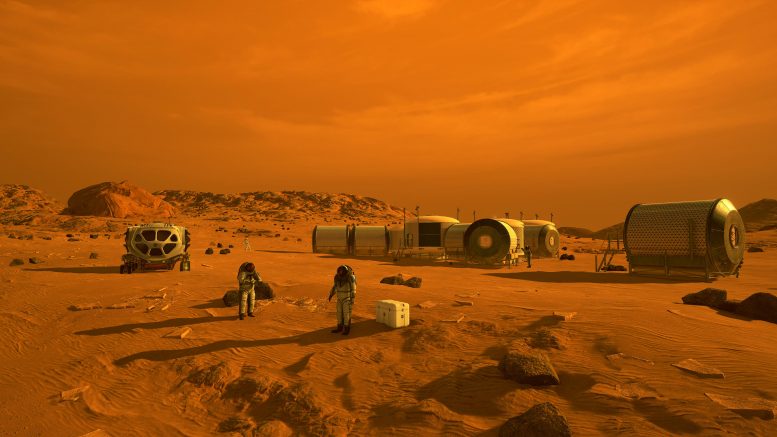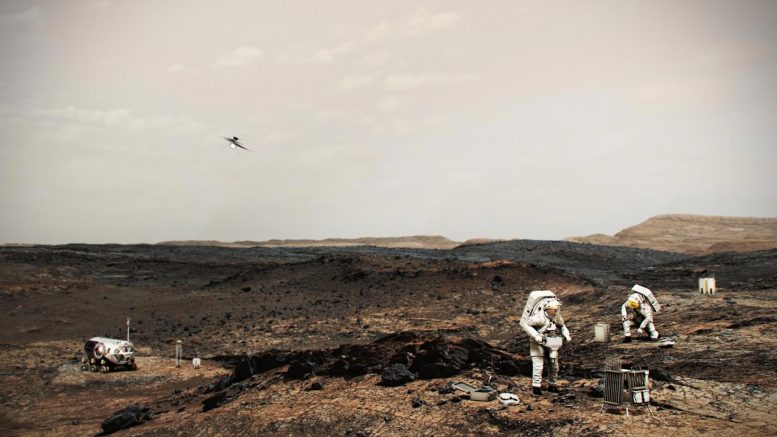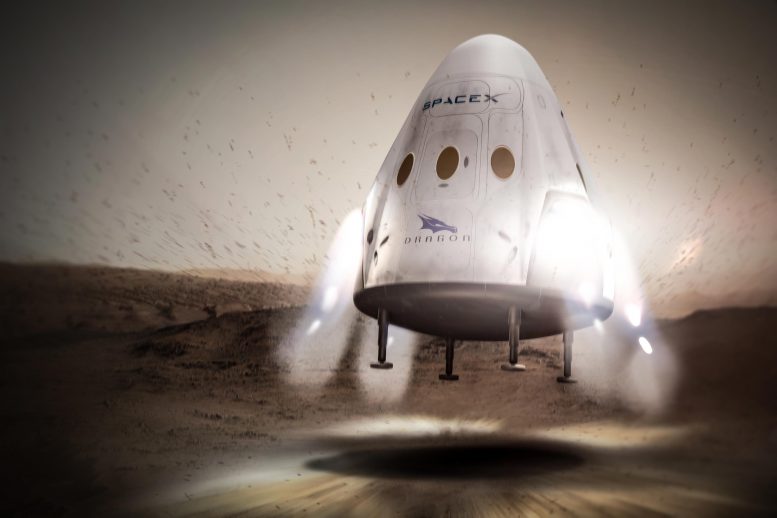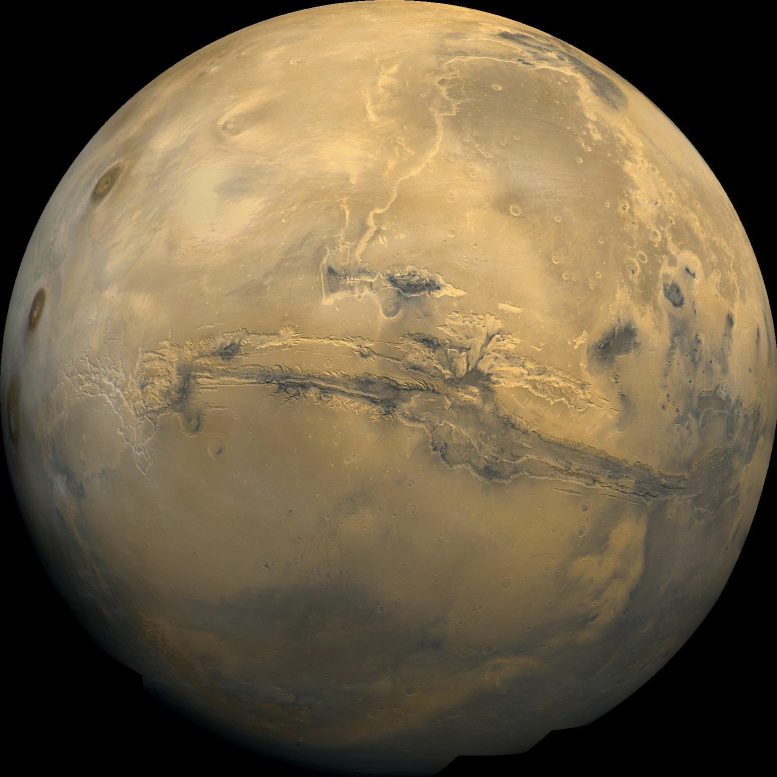
This artist’s concept depicts astronauts and human habitats on Mars. NASA’s Mars Perseverance rover carries a number of technologies that could make Mars safer and easier to explore for humans. Credit: NASA
There are many things humanity must overcome before any return journey to Mars is launched.
The two major players are NASA and SpaceX, which work together intimately on missions to the International Space Station but have competing ideas of what a crewed Mars mission would look like.
Size matters
The biggest challenge (or constraint) is the mass of the payload (spacecraft, people, fuel, supplies, etc.) needed to make the journey.
We still talk about launching something into space being like launching its weight in gold.
The payload mass is usually just a small percentage of the total mass of the launch vehicle.
For example, the Saturn V rocket that launched Apollo 11 to the Moon weighed 3,000 tonnes.
But it could launch only 140 tonnes (5% of its initial launch mass) to low Earth orbit, and 50 tonnes (less than 2% of its initial launch mass) to the Moon.
Mass constrains the size of a Mars spacecraft and what it can do in space. Every maneuver costs fuel to fire rocket motors, and this fuel must currently be carried into space on the spacecraft.
SpaceX’s plan is for its crewed Starship vehicle to be refueled in space by a separately launched fuel tanker. That means much more fuel can be carried into orbit than could be carried on a single launch.
Time matters
Another challenge, intimately connected with fuel, is time.
Missions that send spacecraft with no crew to the outer planets often travel complex trajectories around the Sun. They use what are called gravity assist maneuvers to effectively slingshot around different planets to gain enough momentum to reach their target.
This saves a lot of fuel, but can result in missions that take years to reach their destinations. Clearly, this is something humans would not want to do.
Both Earth and Mars have (almost) circular orbits and a maneuver known as the Hohmann transfer is the most fuel-efficient way to travel between two planets. Basically, without going into too much detail, this is where a spacecraft does a single burn into an elliptical transfer orbit from one planet to the other.
A Hohmann transfer between Earth and Mars takes around 259 days (between eight and nine months) and is only possible approximately every two years due to the different orbits around the Sun of Earth and Mars.
A spacecraft could reach Mars in a shorter time (SpaceX is claiming six months) but — you guessed it — it would cost more fuel to do it that way.
Safe landing
Suppose our spacecraft and crew get to Mars. The next challenge is landing.
A spacecraft entering Earth is able to use the drag generated by interaction with the atmosphere to slow down. This allows the craft to land safely on the Earth’s surface (provided it can survive the related heating).
But the atmosphere on Mars is about 100 times thinner than Earth’s. That means less potential for drag, so it isn’t possible to land safely without some kind of aid.
Some missions have landed on airbags (such as NASA’s Pathfinder mission) while others have used thrusters (NASA’s Phoenix mission). The latter, once again, requires more fuel.
Life on Mars
A Martian day lasts 24 hours and 37 minutes but the similarities with Earth stop there.
The thin atmosphere on Mars means it can’t retain heat as well as Earth does, so life on Mars is characterized by large extremes in temperature during the day/night cycle.
Mars has a maximum temperature of 30℃ (86ºF), which sounds quite pleasant, but its minimum temperature is -140℃ (-220ºF), and its average temperature is -63℃ (-81ºF). The average winter temperature at the Earth’s South Pole is about -49℃ (-56ºF).
So we need to be very selective about where we choose to live on Mars and how we manage temperature during the night.
The gravity on Mars is 38% of Earth’s (so you’d feel lighter) but the air is principally carbon dioxide (CO₂) with several percent of nitrogen, so it’s completely unbreathable. We would need to build a climate-controlled place just to live there.
SpaceX plans to launch several cargo flights including critical infrastructure such as greenhouses, solar panels and — you guessed it — a fuel-production facility for return missions to Earth.
Life on Mars would be possible and several simulation trials have already been done on Earth to see how people would cope with such an existence.

This illustration shows NASA astronauts working on the surface of Mars. A helicopter similar to the Ingenuity Mars Helicopter is airborne at left. Ingenuity is being carried aboard the Perseverance rover; it was recently deployed to the Martian surface to test whether future helicopters could accompany robotic and human missions. Credit: NASA
Return to Earth
The final challenge is the return journey and getting people safely back to Earth.
Apollo 11 entered Earth’s atmosphere at about 40,000km/h (25,000 mph), which is just below the velocity required to escape Earth’s orbit.
Spacecraft returning from Mars will have re-entry velocities from 47,000km/h to 54,000km/h (29,000 mph to 34,000 mph), depending on the orbit they use to arrive at Earth.
They could slow down into low orbit around Earth to around 28,800km/h (17,900 mph) before entering our atmosphere but — you guessed it — they’d need extra fuel to do that.
If they just barrel into the atmosphere, it will do all of the deceleration for them. We just need to make sure we don’t kill the astronauts with G-forces or burn them up due to excess heating.
These are just some of the challenges facing a Mars mission and all of the technological building blocks to achieve this are there. We just need to spend the time and the money and bring it all together.
Written by Chris James, Lecturer, Centre for Hypersonics, The University of Queensland.
Adapted from an article originally published on The Conversation.![]()












The main issue being ignored is the need for artificial gravity in route. Without artificial gravity in route the astronauts will have to crawl out of the spaceship once on Mars. A fully functioning astronaut is one who has been conditioned to the gravity on Mars, or Earth, during the journey. Treadmills be damned, use a revolving capsule to live and work in during the trip. Go into microgravity as required but not all of the time.
One way to get to Mars faster would be to go towards the moon, swing around the moon. Then use the Earth for gravity assist to Mars. Might then have to wait for the right time for the position of the moon.
Why? Why go there? Won’t we just start messing with the climate there, ruining the environment there like we’re doing here?
Not to mention all of the stellar and cosmic radiation that the crew would likely absorb in transit and on the surface.
So Chris, has the ‘Cabin Fever’ problem been addressed? You do know what I mean by that don’t you?
Astronauts all cooped up and nowhere to go; to get away from each other, take a space stroll, some solitude, alone time.
Anything to keep from killing each other.
Eh?
No mention of the radiation issues. Both in deep space and on Mars. You may survive the mission only to be riddled with cancer on your return.
However…
“Space is the natural habitat of humans. A planet, is after all, is a object in space.” – Frank Herbert
So….. where’s the Boring tunneler? Clearly Elon’s companies on Earth are just a trial run and funding source for Mars. They’ll have an entire subterranean city and solar+storage farm built before anyone steps foot on the Red Planet.
Wouldn’t it be more secure to live be on Mars underground? Elon Musk’s borer would make short work of it. Especially if it could be done remotely.
Improve earth.stop spoiling earth.Lets make earth heaven again
What about if we all stop for a moment and better think about how to save our own planet earth 🌎 which is suffering due to our negligence! Let’s make our own paradise and then if you want to leave in Jupiter! Go ahead and do it! But let’s save our own planet first! Stop destroying it.
What about if we all stop for a moment and better think about how to save our own planet earth 🌎 which is suffering due to our negligence! Let’s make our own paradise and then if you want to live in Jupiter! Go ahead and do it! But let’s save our own planet first! Stop destroying it. Spending millions of dollars in stupid stuff while our beautiful sea lions’ home have been destroy due to climate change! WHAT ABOUT IF WE THINK FIRST HOW WE CAN RECOVER OUR MOTHER EARTH 🌎 FIRST!!!
I think this will never happen as there is no signs in any religion discussing life expect this planet. This will not happen.
If humans are sent to Mars it should be with the intention of it being permanent. Not like it was going to the moon and then not going back now going on 50 plus years. Just make the commitment like Kennedy did and do it! Life’s a dance, you learn as you go.
I agree there are lots of issues with traveling to Mars
Well the climate change is because of Joe Biden so lets thank him for killing all our precious animals effected by this stupid Presidential decision on f’ing with our climate change acting like there ain’t nothing at risk with trying to change it. honestly Trump is our only saviour and I’m Mexican and had family taken by immigration but Trump has more potential than Biden ever will. Biden is hurting us Mexican more than Trump ever had. by taking the jobs we came to the US 🇺🇸 for in the first place climate change is not what we need. And our presence on Mars should and will help the chance at further life on Mars even though death is a possibility and will happen but it will also help transforming Mars to a liveable planet in the process.
There are so many issues going there. The landing might be one of the trickiest since they need a lot of supplies with them. Enough food (edible and healthy), oxygen and water. And also having enough fuel to go back. I do not see this happening any time soon.
why cracking heads for what is not necessary knowing that death will still come. pls use your time For God.